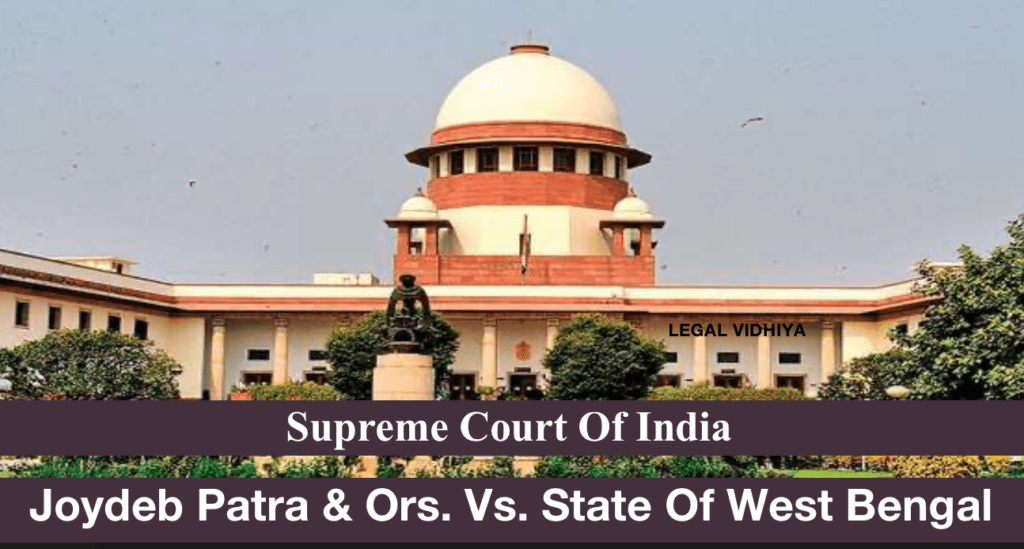
| Citation | 2013 CrLJ 2729 (SC) |
| Date of Judgement | 6th March 2013 |
| Court | Supreme Court (Criminal Appellate Jurisdiction) |
| Case Type | Criminal Appeal No. 203 of 2007 |
| Case Category | Matters relating to harassment, cruelty to women for dowry, dowry death, eve teasing, domestic violence, etc. |
| Appellant/Petitioner/Plaintiff | Joydeb Patra and Ors. |
| Respondents/Defendant | State of West Bengal |
| Bench | Hon’ble Justice A.K. Patnaik & Hon’ble Justice S.J. Mukhopadhaya |
| Sections Referred | Indian Evidence Act, 1872 – Section 106; Indian Penal Code 1860, (IPC) – Section 34, 302 |
| Cases Referred | Sucha Singh v. State of Punjab: (2001) 4 SCC 375; Vikramjit Singh v. State of Punjab: (2006) 12 SCC 306 |
BRIEF HISTORY-
The present case is an appeal against the judgment dated 28.07.2006 of the Division Bench of the Calcutta High Court in Criminal Appeal No. 397 of 1988 filed by the appellant, Joydeb Patra and Ors. against the defendant, State of West Bengal.
FACTS-
Madhabi Patra, the victim @ Khendi got married to Joydeb Patra, the appellant no. 1 in the present case. Through the marriage, she got a daughter and while she was pregnant with her second child for the next nine months, a ceremonial function called ‘Sadh’, also termed to be a Bengali baby shower, was arranged on 18th Baisak, 1393 B.S. After this function, Madhabi fell ill and her condition deteriorated quickly and she died late the same night.
The case was filed in the High Court of Calcutta against the appellant for the charges of murder u/s 302 of IPC, 1860 where the conviction was found solely on the evidence of P.W. 12 who conducted the post-mortem. After the investigation was conducted, a charge sheet was filed against Appellant No. 1 and his whole family who were tried and convicted u/s 302/304 of IPC, 1860.
It was argued by the prosecution in SC that Madhabi died because of the poison given to her in the food by the Appellants. The onus was on the Appellants to prove that the deceased did not die on the account of homicide but suicide. The post-mortem report didn’t state the cause of the death, so he preferred to wait for the chemical analysis report which stated the death was not due to poisoning. Later, an inquest report was prepared on 3rd May 1986 stating that though the relatives of the deceased stated that the deceased died due to poison, no froth was seen on the face of the deceased at the time of the death.
The accused persons filed an appeal to the High Court of Calcutta where the order of conviction remained the same. The father and sister of Appellant No. 3 died during the course of appeal in HC and SC.
ISSUES-
- Whether the death of the deceased (Madhabi) due to poisoning by appellants or was it a suicide?
ARGUMENTS-
The onus to prove lies upon the appellants that the death of the deceased was a suicide and not a homicide. The appellants relied on the post-mortem report which didn’t state the cause of the death. They then waited for a chemical analysis report which clearly stated that no poison could be detected in the viscera of Madhabi Patra. It was argued on behalf of the deceased that the death was caused due to poisoning by the appellants. The counsel for the state submitted that the death took place under very serious circumstances and when the medical facilities were near the place of occurrence of the event, the appellants had the scope to avail them and this conduct gave the prosecution to believe that they were guilty of the offence.
JUDGEMENT-
The SC held that the Trial court and the High court should not have relied solely on the evidence of the one who conducted the post-mortem report after more than two years when it was nowhere mentioned in any of the reports. Since the prosecution failed to establish beyond a reasonable doubt that poison was the cause of the death, the very foundation of the case stood demolished.
The court states that they cannot accept the submission of the counsel on behalf of the state. The court has repeatedly that the onus is on the prosecution and it is only when the burden is discharged that the accused can prove that he is not guilty u/s 106 of the Indian Evidence Act. As the prosecution was not able to establish the guilt beyond a reasonable doubt, the SC allowed the appeal to set aside the impugned judgment of the High Court and the Trial court and directed the bail bonds of the appellants to be discharged.
REFERENCES-
This article is written by Anshula Grover of Shoolini University, an Intern at Legal Vidhiya.




0 Comments